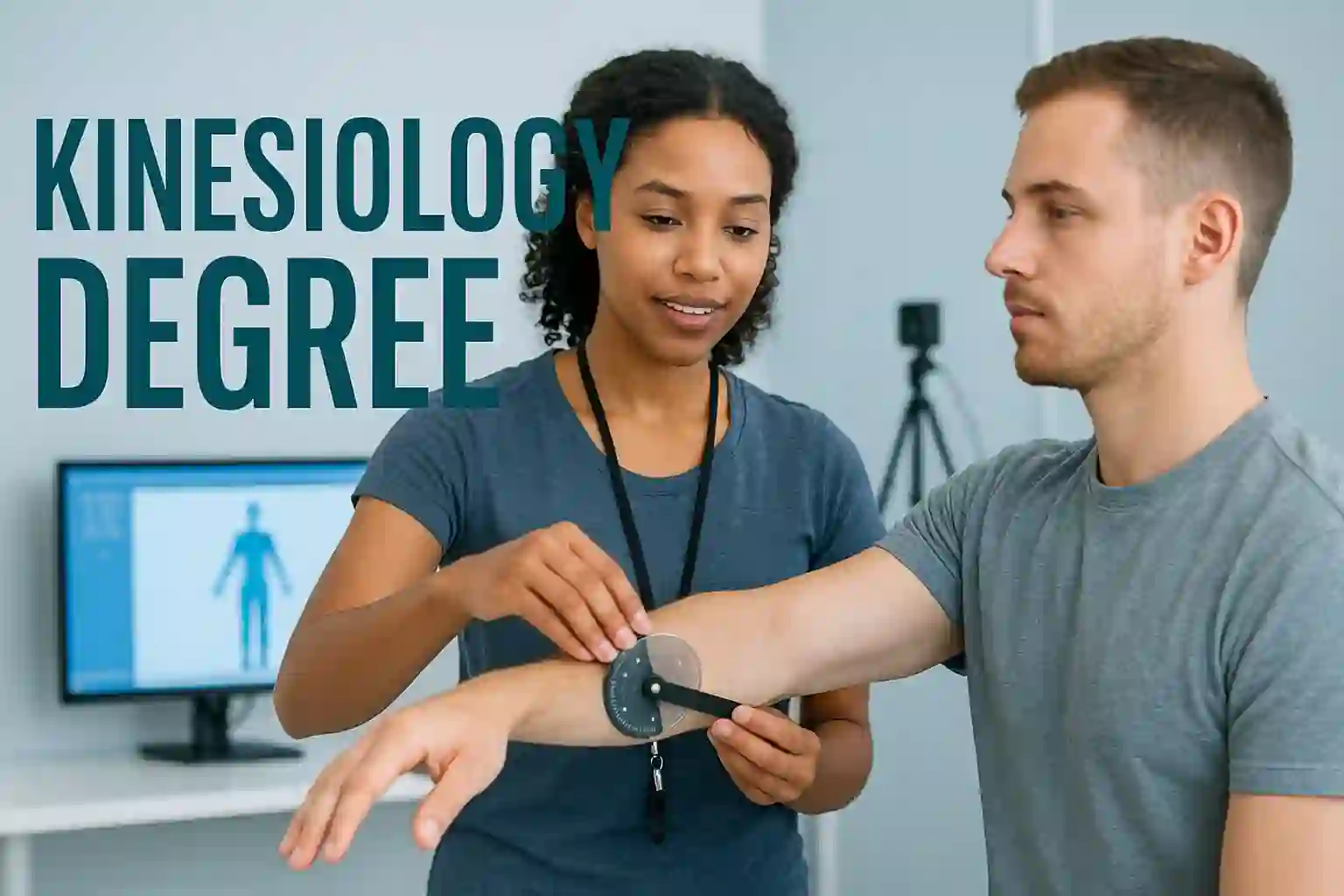Kinesiology Degree in the USA: Comprehensive guide

In the United States, health, wellness, and human performance have become top priorities, fueling interest in the science of movement. Kinesiology—the study of human movement has emerged as a dynamic, versatile, and in-demand field. From athletic performance to rehabilitation, public health, and research, a kinesiology degree in the USA opens doors to a wide range of career opportunities.
This comprehensive guide covers everything aspiring students need to know, including:
- What kinesiology is and why it matters?
- Degree levels in the U.S. and how programs are structured
- Core courses, electives, and concentrations
- Internship, lab, and research opportunities
- Career paths and salary expectations in the U.S.
- How to choose the right program
- Future trends in kinesiology
By the end, you will understand how to navigate U.S. programs and maximize the value of your kinesiology degree.
What Is Kinesiology?
Table of Contents
Kinesiology is the scientific study of human movement. It examines how muscles, bones, and joints work together, how the nervous system controls motion, and how exercise affects overall health. In the U.S., kinesiology programs often combine knowledge from:
- Exercise physiology – understanding how the body responds to activity
- Biomechanics – analyzing forces that act on the body during movement
- Motor control and learning – studying how humans acquire and refine movement skills
- Sports psychology – exploring mental and emotional factors affecting performance
- Health and wellness – promoting physical activity for disease prevention and overall health
Kinesiology bridges science and practice, making it relevant for careers in healthcare, athletics, research, and public health.
Why Pursue a Kinesiology Degree in the USA?
High Demand for Health and Fitness Professionals
In the United States, sedentary lifestyles and chronic conditions like obesity, diabetes, and heart disease have led to growing demand for movement professionals. The U.S. Bureau of Labor Statistics predicts continued growth for careers in fitness, rehabilitation, and allied health, creating robust opportunities for kinesiology graduates.
Pathway to Advanced Healthcare Programs
A kinesiology degree provides foundational knowledge required for graduate studies in:
- Physical Therapy (PT)
- Occupational Therapy (OT)
- Physician Assistant (PA) programs
- Chiropractic and sports medicine
- Exercise physiology graduate programs
Many U.S. universities structure their kinesiology programs to include pre-requisite courses for these advanced professional paths.
Versatile Career Options
Graduates can enter diverse fields, including athletic training, strength and conditioning, clinical rehabilitation, research, ergonomics, wellness coordination, and teaching.
Meaningful Impact
Kinesiology careers focus on helping people improve quality of life—whether preventing injury, restoring function after trauma, or enhancing athletic performance.
Levels of Kinesiology Degrees in the USA
Associate’s Degree
- Duration: ~2 years
- Purpose: Entry-level foundation in movement science, fitness, or health
- Outcome: Careers as fitness aides, rehabilitation assistants, or transfer to a bachelor’s program
Bachelor’s Degree (BS/BA in Kinesiology)
- Duration: ~4 years (120 credit hours typical)
- Purpose: Core qualification covering anatomy, physiology, biomechanics, exercise science, and research
- Outcome: Entry into careers or graduate programs
Example U.S. programs:
- Penn State University – BS in Kinesiology with tracks in Exercise Science and Sport Science
- University of Florida – BS in Applied Physiology and Kinesiology
- University of Texas at Austin – BS in Kinesiology with options in Health Promotion and Exercise Science
Master’s Degree (MS/MSc in Kinesiology)
- Duration: 1–2 years
- Focus: Advanced specialization in exercise physiology, biomechanics, motor control, or sports psychology
- Outcome: Clinical roles, research positions, leadership, and teaching
Example programs:
- University of Michigan – MS in Kinesiology (Exercise Science Track)
- Ohio State University – MS in Kinesiology (Motor Control and Learning)
Doctorate (PhD/EdD/DSc in Kinesiology)
- Duration: 3–5 years
- Focus: Research-intensive, preparing for academic or high-level clinical roles
- Outcome: University professor, principal investigator, or senior researcher
Kinesiology Degree Curriculum in the USA
Curricula vary by university but typically include the following domains:
Core Subjects
- Anatomy & Physiology – structure and function of the human body
- Exercise Physiology – how the body responds and adapts to exercise
- Biomechanics – analysis of motion and forces on the body
- Motor Learning & Control – neural and mechanical control of movement
- Sports Psychology – motivation, stress, performance
- Nutrition & Metabolism – fueling performance and health
- Research Methods & Statistics – experimental design, data analysis
Electives and Specializations
Students can choose from areas such as:
- Strength & Conditioning
- Rehabilitation & Therapeutic Exercise
- Adaptive Physical Activity
- Neuromuscular Physiology
- Ergonomics and Workplace Safety
Lab and Field Work
Hands-on labs include:
- Motion capture and gait analysis
- EMG (electromyography) and muscle testing
- Force plates and biomechanics assessment
- Fitness testing and exercise prescription
Internships are required in many U.S. programs, providing real-world experience in clinics, gyms, or sports teams.
Skills Developed in a U.S. Kinesiology Program
- Analytical skills – interpreting biomechanical and physiological data
- Communication skills – explaining complex concepts to clients, patients, or teammates
- Practical skills – lab techniques, exercise testing, rehabilitation protocols
- Problem-solving – designing individualized programs for diverse populations
- Ethical and professional practice – following U.S. healthcare and research standards
Popular Concentrations in U.S. Kinesiology Programs
Exercise Science & Performance
- Focus: Athletic performance, exercise testing, sports conditioning
- Careers: Strength coach, personal trainer, exercise physiologist
Rehabilitation & Clinical Kinesiology
- Focus: Injury recovery, therapeutic exercise, functional movement
- Careers: Rehabilitation specialist, assistant to PT or OT
Biomechanics & Movement Analysis
- Focus: Motion analysis, injury prevention, performance optimization
- Careers: Biomechanist, movement analyst, researcher
Health Promotion & Community Wellness
- Focus: Exercise programs for populations, public health interventions
- Careers: Wellness coordinator, health coach, community health educator
Internship and Research Opportunities in the USA
- Laboratory Work: Motion capture labs, EMG labs, metabolic testing
- Clinical Internships: Hospitals, rehabilitation centers, physical therapy offices
- Athletic Programs: College or professional team internships
- Research Projects: Faculty-led research in biomechanics, motor control, sports performance
Many U.S. programs encourage students to gain practical experience early, which is critical for career readiness.
Career Paths & Salaries in the USA
According to U.S. data (Bureau of Labor Statistics, 2024 estimates):
| Career | Setting | Median Salary | Job Outlook |
|---|---|---|---|
| Exercise Physiologist | Hospitals, cardiac rehab | $52,000 | 10% growth |
| Physical Therapy Assistant | Clinics, hospitals | $60,000 | 6% growth |
| Strength & Conditioning Coach | College teams, private gyms | $45,000–$70,000 | 8% growth |
| Wellness Program Manager | Corporations, public health | $65,000 | 7% growth |
| Biomechanist / Movement Analyst | Universities, research labs | $70,000 | 12% growth |
| Sport Psychology Assistant | Sports teams, clinics | $55,000 | 6% growth |
Note: Salaries vary by location, experience, and employer.
Accreditation and Professional Organizations
U.S. kinesiology students should pay attention to accreditation and professional certification:
- CAAHEP – Commission on Accreditation of Allied Health Education Programs
- ACSM – American College of Sports Medicine
- NSCA – National Strength and Conditioning Association
- NASM – National Academy of Sports Medicine
Accreditation ensures programs meet U.S. standards for quality education and employability. Professional organizations provide certifications, networking, and career support.
Choosing the Right Kinesiology Program in the USA
When selecting a program, consider:
- Accreditation & Reputation – Ensures quality and recognition
- Curriculum & Specializations – Matches your career goals
- Internships & Lab Facilities – Hands-on learning opportunities
- Faculty Expertise & Research – Mentorship and research exposure
- Location & Costs – Tuition, living expenses, cost of living
- Graduate Outcomes – Job placement and graduate school admissions
Top U.S. programs include:
- University of Florida – Applied Physiology & Kinesiology
- Penn State University – Kinesiology BS
- University of Michigan – Exercise Science MS
- Texas A&M University – Kinesiology BS
Future Trends in Kinesiology (USA Focus)
- Wearable Technology: Motion sensors and fitness trackers for data-driven training
- Telehealth & Remote Coaching: Expanding access to rehab and exercise programs
- AI & Data Analytics: Performance modeling, injury prediction, and health monitoring
- Aging Population: Programs focusing on mobility, fall prevention, and longevity
- Inclusive & Adaptive Programs: Exercise for diverse abilities and populations
Staying updated with U.S. trends will make kinesiology graduates highly competitive.
FAQs: Kinesiology in the USA
Can a kinesiology degree lead to physical therapy?
Yes, many U.S. students use kinesiology as a pre-PT pathway, completing prerequisite courses and gaining clinical experience.
How long is a bachelor’s degree in kinesiology?
Typically 4 years (120 credit hours).
Are internships required in U.S. programs?
Most accredited programs require hands-on experience, usually 200–300 hours.
Can I study kinesiology online in the U.S.?
Some theory courses are online, but labs and internships are usually in-person.
What is the job market like in the U.S.?
High demand in healthcare, fitness, rehabilitation, and wellness sectors, especially in urban centers.
Tips for Success in U.S. Kinesiology Programs
- Strengthen foundational sciences: biology, chemistry, physics
- Participate in labs and practicals early
- Gain internships and research experience
- Network with professionals and join U.S. associations (ACSM, NSCA)
- Maintain a strong GPA for graduate school eligibility
- Stay updated with trends in U.S. sports, rehab, and wellness
Summary
A kinesiology degree in the USA is a versatile and rewarding pathway. It opens doors to careers in health, rehabilitation, sports performance, wellness, and research. By choosing an accredited program, gaining practical experience, and focusing on emerging trends, students can maximize career opportunities and make a real impact on individuals and communities.
Whether your goal is to work with elite athletes, rehabilitate patients, or advance scientific research, a U.S. kinesiology degree provides the knowledge, skills, and credibility needed to succeed.
>> How Long Does It Take to Get a Bachelor’s Degree?
>> What Can I Do With a Theology Degree? Career Paths, Jobs & Opportunities



